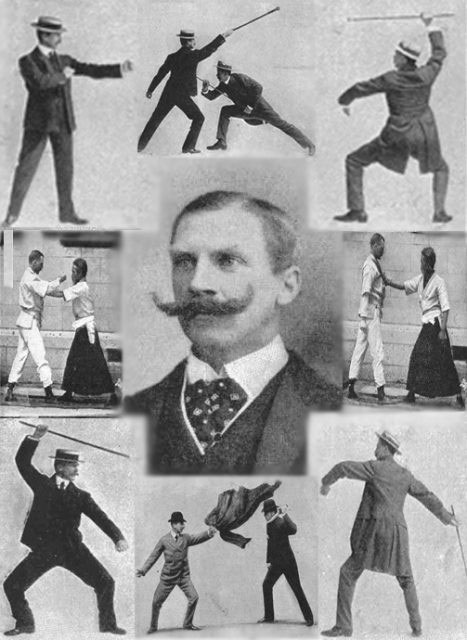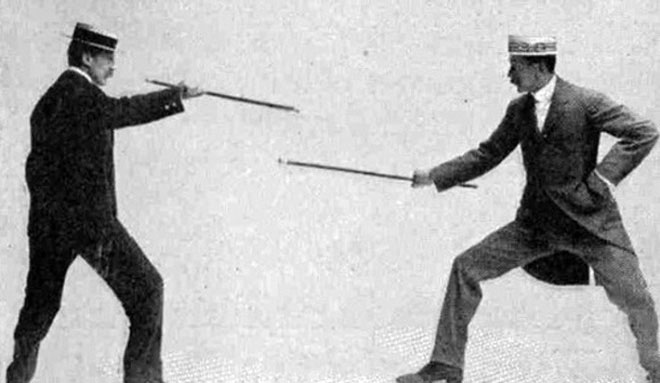Bartitsu: Martial arts are specifically for old gentlemen
A martial art helps gentlemen defend in dangerous situations, but still retains its nobility to remember the delicate and delicate tactics.
We often know martial arts such as Kungfu, Wushu, rights, etc., are the crystallization of the culture and history of Asian countries. But few know that there is a special martial art in the world, originating from England and only for old gentlemen, that is "Bartitsu" martial art.
Used for self-defense purposes, Bartitsu is considered one of the first Western martial arts, the creative result of Edward William Barton-Wright. He came to Japan in the 1890s, from an ordinary railway engineer, Barton-Wright then became a man with a strong passion for martial arts.

Portrait of Barton-Wright and Bartitsu's basic moves.
From the love of Cherry Blossom's Jujitsu , Barton-Wright returned to England in 1899, combining Jujitsu with the available knowledge of boxing and kickboxing to mix and create. so Bartitsu. Bartitsu's combat skills are varied, including melee combat, walking stick combat, using a hat or a portable umbrella as a true weapon.
Barton-Wright then began to share his martial arts in major magazines, typically Pearson's Magazine, in articles he often explained about Bartitsu's collective method, purpose and philosophy of martial arts. . Interestingly, Bartitsu's name is a combination of his name and the word "Jujitsu".

Bartitsu is a martial art that uses walking sticks, hats, and umbrellas, items that an English gentleman used to take with him when he went to the street.
Not long after, martial arts became popular in the UK, attracting a large number of people to study. The academy and Bartitsu martial arts club were founded. Suddenly wealthy aristocrats in London at that time flocked to school Bartitsu, teaching "master" Barton-Wright.
Recognizing the need, Barton-Wright gathered martial arts teachers from both Europe and Japan to develop Baritsu, aiming to teach people a comprehensive course of self-defense in case of attack. , plundering or letting go with someone for example.
Bartitsu's famous masters could include Kaneo Tani, Seizo Yamamoto and Yukio Tani from Japan, Swiss wrestler Armand Cherpillod, martial arts master Pierre Vigny from France.
By 1901, the club had both fencing exercises, breathing exercises, becoming a required part of Bartitsu's teaching lesson plan. Masters often organize spectacular performances, show their techniques and effectiveness with real-world examples.

Bartitsu's peak has attracted the attention of the nobility.
Bartitsu's style is geared towards the ability to confront many opponents, particularly "bishop" Barton-Wright once proved himself to be able to at once take down 7 opponents with muscular bodies.
Since then, Barton-Wright has received a lot of respect and respect. He even saw Edward, the Prince of Wales at that time. Unfortunately, because of a small accident, he had to miss this one-year opportunity.
Non-stop, Barton-Wright is also the author of Sherlock Holmes, Mr. Authur Conan Doyle compares martial arts skills to his legendary character. If you turn over the story, you can see that Holmes mentioned Bartitsu in the "Drum of Adventure" written in 1903.
Sadly, even though martial arts became extremely popular in the first few years, by the time around 1902, it had faded away. The reason is that the cost of studying is too expensive, the curriculum is too complicated. Bartitsu's club began to stagnate, people no longer felt excited, new members were less.

Although it was gone, there were still Bartitsu classes opened today.
Shortly after Bartitsu's academy closed, the masters abandoned the club and opened their own dojo or did other martial arts-related work. On Barton-Wright's side, although he tried to bring Bartitsu back to a glorious time again, he still only received defeat. By about 1920, this martial art was almost forgotten.
So far, Bartitsu has been a valuable resource for martial arts researchers to deepen their study, an interesting example of the martial arts idea for gentlemen of ancient Europe.
- How did the crimes of Vo Tac Thien get passed down by folk?
- Why do some martial arts ask practitioners to scream when they strike?
- Things you don't know about MMA - 'martial arts' have just caused Chinese martial arts to fail
- New training method 'high martial arts'
- The martial arts are doing
- Congress of martial arts for robots
- Because where is Vo Tac Thien tru, both of them are the middle-minded one, please help her?
- The power struggle between the mother and daughter of Vo Tac Thien (2)
- Power struggle between mother and son Vo Tac Thien (1)
- Japan - Martial arts player
- Discovered the Le hat of the time painted with gold
- Learn about Bruce Lee's
 'Fine laughs' - Scary and painful torture in ancient times
'Fine laughs' - Scary and painful torture in ancient times The sequence of numbers 142857 of the Egyptian pyramids is known as the strangest number in the world - Why?
The sequence of numbers 142857 of the Egyptian pyramids is known as the strangest number in the world - Why? History of the iron
History of the iron What is alum?
What is alum?